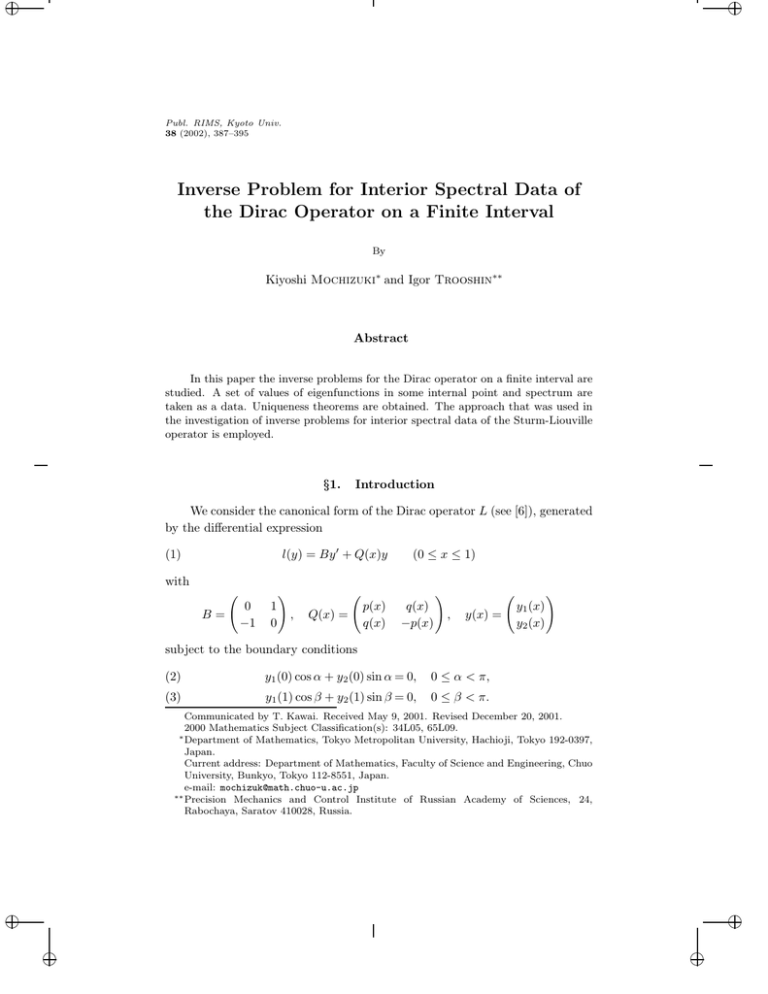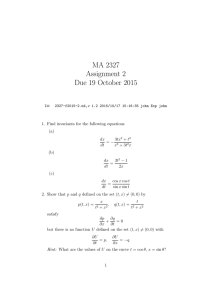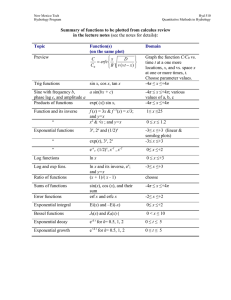Full-Text PDF
advertisement

i
i
Publ. RIMS, Kyoto Univ.
38 (2002), 387–395
Inverse Problem for Interior Spectral Data of
the Dirac Operator on a Finite Interval
By
Kiyoshi Mochizuki∗ and Igor Trooshin∗∗
Abstract
In this paper the inverse problems for the Dirac operator on a finite interval are
studied. A set of values of eigenfunctions in some internal point and spectrum are
taken as a data. Uniqueness theorems are obtained. The approach that was used in
the investigation of inverse problems for interior spectral data of the Sturm-Liouville
operator is employed.
§1.
Introduction
We consider the canonical form of the Dirac operator L (see [6]), generated
by the differential expression
l(y) = By + Q(x)y
(1)
with
B=
0
−1
1
0
(0 ≤ x ≤ 1)
,
Q(x) =
p(x)
q(x)
q(x)
−p(x)
,
y(x) =
y1 (x)
y2 (x)
subject to the boundary conditions
(2)
y1 (0) cos α + y2 (0) sin α = 0,
0 ≤ α < π,
(3)
y1 (1) cos β + y2 (1) sin β = 0,
0 ≤ β < π.
Communicated by T. Kawai. Received May 9, 2001. Revised December 20, 2001.
2000 Mathematics Subject Classification(s): 34L05, 65L09.
∗ Department of Mathematics, Tokyo Metropolitan University, Hachioji, Tokyo 192-0397,
Japan.
Current address: Department of Mathematics, Faculty of Science and Engineering, Chuo
University, Bunkyo, Tokyo 112-8551, Japan.
e-mail: mochizuk@math.chuo-u.ac.jp
∗∗ Precision Mechanics and Control Institute of Russian Academy of Sciences, 24,
Rabochaya, Saratov 410028, Russia.
i
i
i
i
i
i
388
Kiyoshi Mochizuki and Igor Trooshin
Throughout this paper we require that p(x), q(x) ∈ C 1 [0, 1] and are real-valued
functions. This regularity assumption is too much restrictive. It seems to be
sufficient only to require that p(x), q(x) ∈ L2 (0.1). In this paper, however, we
do not enter into this problem.
As is well known, the operator L has a discrete spectrum consisting of
simple eigenvalues λn , n ∈ Z. We denote by yn (x) = (yn,1 (x), yn,2 (x))T , n ∈
Z, the corresponding eigenfunctions.
Research of inverse problems for Dirac operator follows investigations of
closely related inverse problems for Sturm-Liouville operator. T. N. Arutyunyan [1] obtained an analog of Marchenko theorem [8], [9]: he proved
that the eigenvalues λn , n = 0, ±1, ±2, . . . and normalising coefficients αn =
yn {L2 (0.1)}2 , n = 0, ±1, ±2, . . . (for yn,1 (0) = sin α, yn,2 (0) = − cos α)
uniquely determined the potential Q(x). M. M. Malamud [7] proved an analog of Borg theorem [2]: he showed that the spectra of two boundary value
problems for an operator with different boundary conditions at one end (and
identical conditions repeated at the other end) uniquely determined the potential Q(x). He also proved an analog of the theorem of Hochstadt and Lieberman
[4]: one spectrum and a potential on the interval (0, 1/2) uniquely determined
the potential Q(x) on the whole interval [0, 1].
The aim of our present work is to investigate a possibility to recover potential from the known eigenvalues and some information on eigenfunctions in the
internal point b ∈ (0, 1). The similar problem for the Sturm-Liouville operator
is formulated and studied in our papers [10], [11]. In these articles we have
employed technique similar to those used in [4], [12].
§2.
Statement of Results
Let us introduce a second Dirac operator L̃ generated by the differential
expression
(4)
l(y) = By + Q̃(x)y
(0 ≤ x ≤ 1),
subject to the same boundary conditions (2), (3). Here
p̃(x)
q̃(x)
Q̃(x) =
q̃(x) −p̃(x)
with a real-valued functions p̃(x), q̃(x) ∈ C 1 [0, 1]. The eigenvalues and the
corresponding eigenfunctions of L̃ are denoted by λ̃n and ỹn (x) = (ỹn,1 (x), ỹn,2
×(x))T (n ∈ Z), respectively.
i
i
i
i
i
i
389
Inverse Problem for Spectral Data
If for any n ∈ Z
Theorem 2.1.
λn = λ̃n ,
yn,1 ( 12 )
ỹn,1 ( 12 )
=
,
yn,2 ( 12 )
ỹn,2 ( 12 )
then p(x) = p̃(x), q(x) = q̃(x) on the [0, 1].
In the case b = 1/2, the uniqueness of Q(x) can be proven if we require
the knowledge of part of the second spectrum.
We denote by µn and µ̃n respectivly the eigenvalues of problems (1) and
(4) subject to the same boundary conditions (2) and
(5)
y1 (1) cos γ + y2 (1) sin γ = 0,
0 ≤ γ < π,
γ = β.
Let l(n), r(n) be sequences of natural numbers with property
n
(1 + 1,n ),
σ1
n
r(n) = (1 + 2,n ),
σ2
l(n) =
0 < σ1 ≤ 1,
1,n → 0,
0 < σ2 ≤ 1,
2,n → 0.
Theorem 2.2.
Let l(n), r(n) and 1/2 < b < 1 are so chosen that
σ1 > 2b − 1, σ2 > 2 − 2b. If for any n ∈ Z
λn = λ̃n ,
µl(n) = µ̃l(n) ,
ỹr(n),1 (b)
yr(n),1 (b)
=
,
yr(n),2 (b)
ỹr(n),2 (b)
then p(x) = p̃(x), q(x) = q̃(x) on the [0, 1].
§3.
Proof of Theorem 2.1
We shall first mention some results which will be needed later.
Let us denote by w(x, λ) = (w1 (x, λ), w2 (x, λ))T and w̃(x, λ) = (w̃1 (x, λ),
w̃2 (x, λ))T the solutions of initial-value problems
Bw + Q(x)w = λw,
w1 (0) = sin α,
w2 (0) = − cos α
and
B w̃ + Q̃(x)w̃ = λw̃,
w̃1 (0) = sin α,
w̃2 (0) = − cos α.
i
i
i
i
i
i
390
Kiyoshi Mochizuki and Igor Trooshin
There exist (see [3], [6]) kernels K(x, t) = (Kij (x, t))2i,j=1 , K̃(x, t) = (K̃ij
×(x, t))2i,j=1 , with entries continuously differentiable on 0 ≤ t ≤ x ≤ 1 such
that
x
w(x, λ) = φ0 (x, λ) +
(6)
K(x, t)φ0 (t, λ)dt,
0
x
K̃(x, t)φ0 (t, λ)dt.
(7)
w̃(x, λ) = φ0 (x, λ) +
0
Here φ0 (x, λ) = (sin(λx + α), − cos(λx + α))T .
Proof of Theorem 2.1. If we multiply (4) (in the sense of scalar product
in R2 ) by w̃(x, λ) and the equation of w̃(x, λ) by w(x, λ) and subtract, after
integrating from 0 to 1/2, we obtain
12
(Q(x) − Q̃(x))w(x, λ), w̃(x, λ)dx
0
1
= (w̃2 (x, λ)w1 (x, λ) − w̃1 (x, λ)w2 (x, λ))|02 .
Since w(x, λ) and w̃(x, λ) satisfy the same initial conditions, it follows that
w̃2 (0, λ)w1 (0, λ) − w̃1 (0, λ)w2 (0, λ) = 0.
Define
P (x) = Q(x) − Q̃(x),
and
p1 (x) = p(x) − p̃(x),
H(λ) =
0
1
2
q1 (x) = q(x) − q̃(x)
P (x)w(x, λ), w̃(x, λ)dx.
Then from the conditions of the theorem it follows that
1
1
1
1
, λn w1
, λn − w̃1
, λn w2
, λn = 0
w̃2
2
2
2
2
and hence
n ∈ Z.
H(λn ) = 0,
We can show from (6), (7) that
12
(8) H(λ) =
p1 (x) − cos 2(λx + α) +
0
R1 (x, t) exp(2iλt)dt
+
R2 (x, t) exp(−2iλt)dt dx +
q1 (x) − sin 2(λx + α)
0
0
x
x
+
R3 (x, t) exp(2iλt)dt +
R4 (x, t) exp(−2iλt)dt dx,
0
x
0
x
1
2
0
i
i
i
i
i
i
Inverse Problem for Spectral Data
391
where Rl (x, t), l = 1, . . . , 4, are piecewise-continuously differentiable on 0 ≤
t ≤ x ≤ 1.
Therefore it follows that H(λ) is an entire function of order no greater
than 1.
We next define the function
ω(λ) = w1 (1, λ) cos β + w2 (1, λ) sin β.
It follows from the formula (6) that
1
ω(λ) = sin(λ + α) cos β +
0
[K(1, t)φ0 (t, λ)]1 dt cos β
− cos(λ + α) sin β +
0
1
[K(1, t)φ0 (t, λ)]2 dt sin β.
Integrating by parts we obtain the following asymptotic relations:
exp(|λ|)
ω(λ) = sin(λ + α − β) + O
(9)
.
λ
The zeros of ω(λ) are the eigenvalues of L and hence it has only simple zeros
λn .
From this and the estimates for ω(λ) and H(λ) it follows that
χ(λ) =
H(λ)
ω(λ)
is the entire function of order no greater than 1.
It follows from asymptotics (9) and formula (8) that χ(λ) is bounded on
any nonreal axis with vertex in origin of λ-plane. Then it follows from the
Phragmen-Lindelöf theorem that χ(λ) = M is constant on the whole λ-plane.
Let us show that M = 0. We can rewrite the equation H(λ) = M w(1, λ)
in the form
12
x
p1 (x) − cos 2(λx + α) +
R1 (x, t) exp(2iλt)dt
0
0
+
R2 (x, t) exp(−2iλt)dt dx +
q1 (x) − sin 2(λx + α)
0
0
x
x
R3 (x, t) exp(2iλt)dt +
R4 (x, t) exp(−2iλt)dt dx
+
0
0
exp(|λ|)
= M sin (λ + α − β) + O
.
λ
x
1
2
i
i
i
i
i
i
392
Kiyoshi Mochizuki and Igor Trooshin
By use of the Rimann-Lebesque lemma, the left side of the above equality
tends to 0 as λ → ∞, λ ∈ R. Thus we obtained that M = 0. We are now going
to show that Q(x) = 0 a.e. on [0, 1/2].
Then we have
12
x
f1 (x) exp(2iλx) +
S11 (x, t) exp(2iλt)dt
0
0
+
S12 (x, t) exp(−2iλt)dt dx +
f2 (x) exp(−2iλx)
0
0
x
x
+
S21 (x, t) exp(2iλt)dt +
S22 (x, t) exp(−2iλt)dt dx = 0,
x
0
1
2
0
where
f1 (x) = −
exp(2iα)
(q1 (x) + ip1 (x)),
2i
f2 (x) =
exp(−2iα)
(q1 (x) − ip1 (x))
2i
and S(x, t) = (Sij (x, t)), i, j = 1, 2, is a matrix with entries which are piecewisecontinuously differentiable on 0 ≤ t ≤ x ≤ 1.
This can be rewritten as
12
12
exp(2iλτ ) f1 (τ ) +
(f1 (x)S11 (x, τ ) + f2 (x)S21 (x, τ ))dx dτ
0
+
0
or
τ
1
2
exp(−2iλτ ) f2 (τ ) +
τ
1
2
0
1
2
(f1 (x)S12 (x, τ ) + f2 (x)S22 (x, τ ))dx dτ = 0,
e0 (λτ), f (τ ) +
1
2
S(x, τ )f (x)dxdτ = 0.
τ
Here e0 (x) = (exp(2ix), exp(−2ix))T and f (x) = (f1 (x), f2 (x))T . Thus from
the completeness of the functions e0 (λτ) in {L2 (0, 1/2)}2, it follows that
f (τ ) +
1
2
S(x, τ )f (x)dx = 0
for 0 < τ <
τ
1
.
2
But this equation is a homogenous Volterra integral equation and has only the
zero solution. Thus we have obtained f (x) = (f1 (x), f2 (x))T = 0 on [0, 1/2]
and consequently p1 (x) = q1 (x) = 0 on [0, 1/2].
To prove that p1 (x) = q1 (x) = 0 on [1/2, 1], we should repeat arguments
for the supplementary problem
l(y) = By + Q1 (x)y,
Q1 (x) = Q(1 − x)
(0 ≤ x ≤ 1)
i
i
i
i
i
i
Inverse Problem for Spectral Data
393
subject to the boundary conditions
y1 (0) cos β + y2 (0) sin β = 0,
§4.
y1 (1) cos α + y2 (1) sin α = 0.
Proof of Theorem 2.2
Let m(n) be a sequence of natural numbers with a property
m(n) =
n
(1 + n ),
σ
0 < σ ≤ 1,
n → 0.
We prove an auxiliary lemma
Lemma 1.
any n ∈ Z
Let m(n) and 0 < b < 1/2 are so chosen that σ > 2b. If for
λm(n) = λ̃m(n) ,
ỹm(n),1 (b)
ym(n),1 (b)
=
,
ym(n),2 (b)
ỹm(n),2 (b)
then p(x) = p̃(x), q(x) = q̃(x) on the [0, b].
Proof. As in the proof of Theorem 2.1 we can show that
(10)
G(λ) =
0
b
P (x)w(x, λ), w̃(x, λ)dx
= (w̃2 (x, λ)w1 (x, λ) − w̃1 (x, λ)w2 (x, λ))|x=b .
where P (x) = Q(x) − Q̃(x). Thus from conditions of Theorem 2.2 it follows
that
G(λm(n) ) = 0, n ∈ Z.
To prove Lemma, as in the proof of the previous theorem, it is enough to
show that G(λ) = 0 on the whole λ -plane.
From formula (8) and asymptotic (9), it follows that an entire function
G(λ) is function of exponential type ≤ 2b. Let us define an indicator of function
G(λ) by the formula:
ln |g(reiθ )|
h(θ) = lim sup
.
r
r→∞
Since |λ| = r| sin θ|, θ = arg λ it follows that
h(θ) ≤ 2b| sin θ|.
i
i
i
i
i
i
394
Kiyoshi Mochizuki and Igor Trooshin
Let us denote by n(r) the number of zeros of G(λ) in the disk |λ| ≤ r.
There are following asymptotics (see e.g., [6]) for λk
1
λn = πn 1 + O
.
n
These asymptotics and assertions of theorem show that
πn
(1 + n ), n → 0.
λm(n) =
σ
Let us now count how many zeroes λn lie inside the disk {|λ| ≤ r}. It is
easy to see that for a sufficiently large r this quantity is
σr
σr
n(r) = 1 + 2
(1 + (r)) = 2 (1 + (r)).
π
π
Here (r) → 0 for r → ∞ and [x] is the integer part of x.
It follows that in the case under consideration
2π
2
4b
2b 2π
n(r)
1
lim
= σ>
=
(11)
| sin θ|dθ ≥
h(θ)dθ.
r→∞ r
π
π
π 0
2π 0
To complete the proof we have to recall the following theorem [5], p. 173:
The set of zeros of every entire function of the exponential type, not identically
zero, satisfies the inequality:
2π
1
n(r)
lim inf
≤
(12)
h(θ)dθ.
r→∞
r
2π 0
This theorem and the inequality (12) implies, that G(λ) ≡ 0 on the whole
λ -plane and, as we already mentioned, it involves p(x) = p̃(x), q(x) = q̃(x) on
[0, b].
Proof of Theorem 2.2.
Firstly let us note that based on the condition
λr(n) = λ̃r(n) ,
ỹr(n),1 (b)
yr(n),1 (b)
=
,
yr(n),2 (b)
ỹr(n),2 (b)
it follows from Lemma 1 that p(x) = p̃(x), q(x) = q̃(x) a.e. on [b, 1].
Eigenfunctions yn (x) and ỹn (x) satisfy the same boundary condition on
the right end. This means that
w(x, λn ) = Cn w̃(x, λn )
on [b, 1] for any n ∈ Z (Cn are constants). Therefore from definition (10) of
function G(ρ) it follows that
g(λn ) = 0,
n∈Z
i
i
i
i
i
i
Inverse Problem for Spectral Data
395
and, in the same way, that
G(µl(n) ) = 0,
∈ Z.
We are going to show that inequality (12) does not take place and consequently, the entire function of the exponential type G(λ) = 0 on the whole
λ-plane. If we count a quantity of λn and µn located inside the disc of radius
r, we have 1 + 2[(r/π) + O(1)] of λn ’s and 1 + 2[(rσ1 /π) + O(1)] of µn ’s.
This means that n(r) = 2 + 2[r(σ1 + 1)/π + O(1)] and
lim
r→∞
2
n(r)
= (σ1 + 1).
r
π
Repeating the last part of the proof of Lemma we can show that G(λ) = 0
identically on the whole λ-plane which implies that p(x) = p̃(x), q(x) = q̃(x)
on [0, b] and, consequently, on [0, 1].
References
[1] Arutyunyan, T. N., Isospectral Dirac operators, Izv. Nats. Akad. Nauk Armenii Mat.,
29 (1994), no. 2, 3–14; English transl. in J. Contemp. Math. Anal., Armen. Acad. Sci.,
29 (1994), no. 2, 1–10.
[2] Borg, G., Eine Umkehrung der Sturm-Liouvilleschen Eigenwertaufgabe, Bestimmung
der Differential gleichung durch die Eigenvert, Acta Math., 78 (1946), 1–96.
[3] Gasymov, M. G. and Levitan, B. M., The Inverse Problem for a Dirac System, Dokl.
Akad. Nauk SSSR, 167 (1966), 967–970.
[4] Hochstadt, H. and Lieberman, B., An Inverse Sturm-Liouville Problem with Mixed
Given Data, SIAM J. Appl. Math., 34 (1978), 676–680.
[5] Levin, B. Ja., Distribution of zeros of entire functions, AMS Transl. Vol.5, Providence,
1964.
[6] Levitan, B. M. and Sargsjan, I. S., Sturm-Liouville and Dirac Operators, Kluwer Academic Publishers, Dodrecht, Boston, London, 1991.
[7] Malamud, M. M., Uniqueness Questions in Inverse Problems for Systems of Differential
Equations on a Finite Interval, Trans. Moscow Math. Soc., 60 (1999), 173-224.
[8] Marchenko, V. A., On certain questions in the theory of differential operators of the
second order, Dokl. Akad. Nauk SSSR, 72 (1950), 457–460 (in Russian).
[9] ———, Some questions in the theory of one-dimensional linear differential operators of
the second order. I, Trudy Moscov. Mat. Obsc., 1 (1952), 327–420 (in Russian); Amer.
Math. Soc. Transl., Ser. 2 101 (1973), 1–104.
[10] Mochizuki, K. and Trooshin, I., Inverse Problem for Interior Spectral Data of SturmLiouville Operator, Seminar Notes of Mathematical Sciences, 3 Ibaraki University,
(2000), 44–51.
[11] ———, Inverse Problem for Interior Spectral Data of Sturm-Liouville Operator, J. Inverse Ill-posed Prob., 9 (2001), 425–433.
[12] Ramm, A. G., Property C for ODE and applications to inverse problems, in Operator theory and applications (Winnipeg, MB, 1998), Fields Inst. Commun., 25, AMS,
Providence, RI, (2000), 15–75.
i
i
i
i




